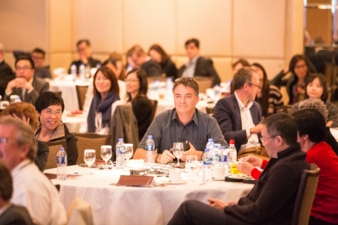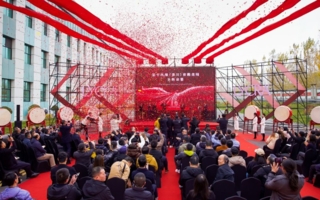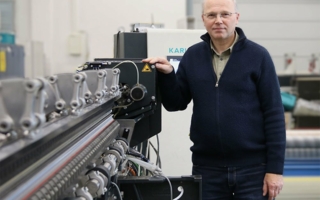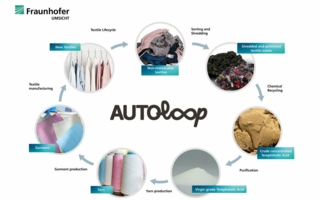20/06/2017 – 12th Prime Source Forum — auf Deutsch lesen
The future of fashion sourcing
Over 40 speakers from all over the world spoke on topics related to the T&A business, trade, marketing, financing, new development and technology.
The event took place in mid-March in Hong Kong and comprised two keynote speeches, six sessions and eight CEO dialogues.
What does the future fashion sourcing landscape hold? Given that the supply chain involves many countries, it is important to keep a flexible mindset and agile operation. Buzzwords used at the Forum included speed, integration, consumer first, collaboration, agility and flexibility. There was general consensus that China would remain a key manufacturer whilst becoming an important large-scale market. Africa is considered the last frontier.
The next 10 years
Manufacturing will be moved closer to the consumers – local for local. E-commerce, online retail, big data collection, fashion platforms, technology and innovation are key components of the T&A industry going forward.
Although China is growing at a slower rate, it is still expanding at 6.5%. China is still a good place for T&A manufacturing. The producers who can survive in China are the best and most successful. They will flourish in spite of rising labour costs. In fact, the increase in wages is helping this industry to grow, restructure, upgrade, transform, differentiate and innovate its production, thus driving China’s T&A industry to the next level. Meanwhile, some of the leading manufacturers in China are setting up operations in foreign countries in a significant way, especially in South-East Asia and Africa. In the next ten years, China’s successful T&A companies will take the money made in China to invest all over the world, following and supported by the Belt & Road Initiative and Made in China 2025. The whole of Asia will emerge as a huge market, with China at the forefront. After all, China is growing fast as a market while shrinking as a manufacturer.
2025
By 2025, there will be 66 new airports, 5,500 railway stations with 120 million overseas tourist holidays being made by Chinese visitors. In the next 5 years, China will be home to 1.34 million HNWIs (High Net Worth Individuals) which corresponds to 54% of the upper middle class. Looking across to India, although the growth of its infrastructure is still lagging behind, it is an interesting place to keep an eye on.
E-commerce is the rising star of fashion supply chain management. Although it is challenging in terms of payment, taxation, regulation and duties, it is nevertheless an exciting area. It not only helps big manufacturers but also the smaller ones, provided logistics cost are kept in check. Five years ago, online trade was a PC business, but today it is a mobile business that is increasingly moving to cloud technology.
Bowing to the growing strength of e-commerce, especially among the millennials who are prime spenders and tech savvy, many retail stores and malls are closing down in the US. The bricks-and-mortar stores are fading in number but are not going away. Shopping malls will continue to function as showrooms where consumers go for a real shopping experience before purchasing their items online. It is important to create a balance between online and offline stores, even at a time when digital stores are gaining market share.
In the era of big data, consumers are eager for differentiation of style. Technology and innovation are driving the next new normal for the T&A industry. There are great business opportunities and more money to be made in the coming years using big data information. Digitalisation will force companies to reinvent themselves. Information and automation will emerge as the leading factors of change and growth. Technology based fashion platforms will drive sales in totally new directions with virtual and augmented reality devices enhancing online sales. Tech savvy millennials will transform the global economy.
China is changing
China is evolving into a very mobile phone-driven economy. It is leading the way in online spending, which accounts for 48.5% of consumer spending in China, 40.3% in Asia, and 32.2% in North America. In 2005, Asian household consumption reached US$ 7tn, rising to an estimated US$ 33tn by 2030. This compares with an expected US$ 17tn in the US and US$ 16tn in the EU. This indicates that Asia will be driving consumption through e-commerce. Both brands and manufacturers need to contribute to this end. Finding a good partner with the same vision is paramount and critical if companies are to work together.
The era of chasing the cheapest price has come to an end. Africa is the last frontier for the T&A industry. It offers a great opportunity to manufacturers of all product types, especially T&A as it employs many workers and helps Africa to earn much needed foreign currencies. Ethiopia has a clear vision to build its country by establishing a quality T&A industry. Its advantage for manufacturing lies in its government endorsing and supporting strategy, unlike those in South-East Asia. The government’s alignment with the industry is critical to its success. The Hawassa Industrial Park, flagship park in Ethiopia with state-of-the-art facilities was built specifically for the T&A industry in just nine months and was opened in 2016.
The Hawassa Industrial Park
The flagship park in Ethiopia with state-of-the-art facilities was built specifically for the T&A industry in just nine months and was opened in 2016. It is the first park with zero discharge and there will be many to follow. The park has access to a good supply of clean energy (hydroelectric power – 3rd largest in Africa) and low energy costs (US$0.30 per kilowatt – cheapest), a new railway system which runs at 120km/hr, an airline network, a labour force of 15 million and a population of 100 million (2nd largest in Africa), as well as a good supply of cotton nearby, and proximity to a sea port. With a 10-year tax exemption, free import and export duties, as well as a good air, land and sea transport network, it has attracted many large, high-quality foreign investors who are opening factories there as land is free of charge for manufacturers.
The current trade policy is in their favour with no duty to pay to Europe and the US under the AGOA. Ethiopia aims to become a major player in the global T&A industry.





